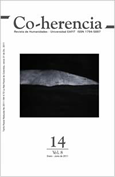From oficial history to individual history: Testimony and meta-testimony in A veinte años, Luz [1998] by Elsa Osorio
Main Article Content
Keywords
Memory, forgetting, identity, dictatorship, resistance
Abstract
A veinte años, Luz, written by Elsa Osorio, places us at the beginning of the dictatorship in Argentina in 1976. The events address the issue of denied identities, that is, the story of the children of leftists who were stolen and given up for adoption. With the birth of the first child of the main character, Luz, questions are raised about her own identity, which had been taken away along with her mother’s life. We assume the hypothesis that the novel establishes a relationship between the past and the present, between the individual and social history, and therefore becomes a lesson that, in turn, creates an ethical dimension in the text. Similarly, the novel exposes that to forget is to betray, and that to remember is another way to resist.
Downloads
Download data is not yet available.
References
Beverley, J. (sf). “Testimonio y política imperial”. Miradas revista del audio-visual. [Documento en línea] Consultado 2008-11-30
Blanco, R. (sf). Sobre la ”Generación postdicatadura. Identidades sociales y discurso emergente”. [Documento en línea] Consultado 2008-11-30
Biraben, G. (2003). La Cautiva. Película.
Caviglia, M. (2006). Dictadura, vida cotidiana y clases medias. Una sociedad dividida. Buenos Aires: Prometeo Libros.
Escudero, L. (2001). “Desaparecidos, pasiones e identidades discurssivas en la prensa Argentina (1976-1986)”. En: Revista de la Facultad de Humanida-des y Ciencias Sociales. 541-548.
Foucault, M. (1991). Saber y verdad. Madrid: Piqueta.
Gatti, G. (2006). “Las narrativas del detenido-desaparecido (o de los pro-blemas de la representación ante las catástrofes sociales”. Connes 27-38.
Osorio, E. (2008). [1998] A veinte años, Luz. Madrid: Siruela Nuevos Tiempos
Maldonado, Nelly (2006) “Tiemos de memoria. Un recorrido por el caso argentino”. En: Intersticios 11. 81-100.
Mèlich, J. (2001). La ausencia del testimonio. Ética y Pedagogía de los retaos del Holocaust. México D.F.: Anthropos.
Mèlich, J. (2006). “El trabajo de la memoria o el testimonio como catego-ría didáctica”. En: Enseñanza de las ciencias sociales.Revista de Investigación. 115-123.
Mendoza, J. (2004). “Las formas del recuerdo. La memoria narrativa”. En:Athenea Digital.
Platón (1998). “Alegoría de la Caverna” Diálogos. Bogotá: El Áncora Edi-tores.
Strejilevich, N. (2005). El arte de no olvidar. Literatura testimonial en Chile, Argentina y Uruguay entre los 80 y los 90. Libro en versión electrónica.
Romero, L. (2008). “La historia política del Nunca Más. La memoria de las dsapariciones en la Argentina (reseña). En: Revista de Historia Iberoameri-cana 2008-1. 104-017.
Vallejos, J. (2006). “Los Rubios, Intelectuales, Crítica Histórica y Trage-dia”. En: El interpretador- Literatura, arte y pensamiento 24. [Documento en línea] Consultado, marzo 2006.
Blanco, R. (sf). Sobre la ”Generación postdicatadura. Identidades sociales y discurso emergente”. [Documento en línea] Consultado 2008-11-30
Biraben, G. (2003). La Cautiva. Película.
Caviglia, M. (2006). Dictadura, vida cotidiana y clases medias. Una sociedad dividida. Buenos Aires: Prometeo Libros.
Escudero, L. (2001). “Desaparecidos, pasiones e identidades discurssivas en la prensa Argentina (1976-1986)”. En: Revista de la Facultad de Humanida-des y Ciencias Sociales. 541-548.
Foucault, M. (1991). Saber y verdad. Madrid: Piqueta.
Gatti, G. (2006). “Las narrativas del detenido-desaparecido (o de los pro-blemas de la representación ante las catástrofes sociales”. Connes 27-38.
Osorio, E. (2008). [1998] A veinte años, Luz. Madrid: Siruela Nuevos Tiempos
Maldonado, Nelly (2006) “Tiemos de memoria. Un recorrido por el caso argentino”. En: Intersticios 11. 81-100.
Mèlich, J. (2001). La ausencia del testimonio. Ética y Pedagogía de los retaos del Holocaust. México D.F.: Anthropos.
Mèlich, J. (2006). “El trabajo de la memoria o el testimonio como catego-ría didáctica”. En: Enseñanza de las ciencias sociales.Revista de Investigación. 115-123.
Mendoza, J. (2004). “Las formas del recuerdo. La memoria narrativa”. En:Athenea Digital.
Platón (1998). “Alegoría de la Caverna” Diálogos. Bogotá: El Áncora Edi-tores.
Strejilevich, N. (2005). El arte de no olvidar. Literatura testimonial en Chile, Argentina y Uruguay entre los 80 y los 90. Libro en versión electrónica.
Romero, L. (2008). “La historia política del Nunca Más. La memoria de las dsapariciones en la Argentina (reseña). En: Revista de Historia Iberoameri-cana 2008-1. 104-017.
Vallejos, J. (2006). “Los Rubios, Intelectuales, Crítica Histórica y Trage-dia”. En: El interpretador- Literatura, arte y pensamiento 24. [Documento en línea] Consultado, marzo 2006.
